CRISPR/Cas9 facilitate to
discover of inhibitors of KRAS,
the difficult-to-target gene in cancer
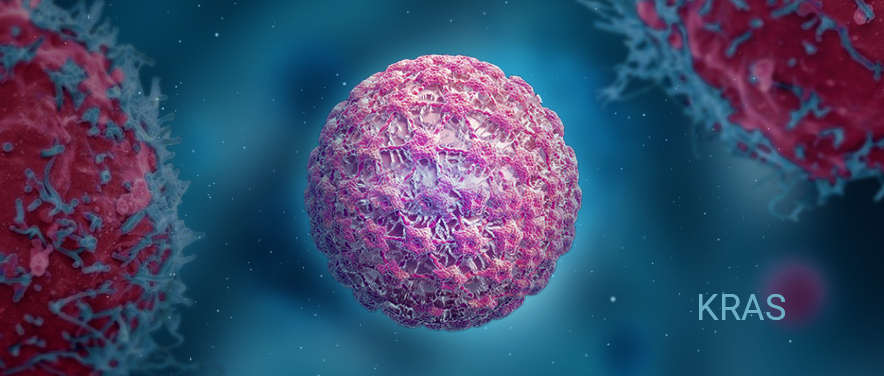
KRAS mutation often occurs in various types
of tumors. About 30% of cancer patients have KRAS gene mutations in their genomes, including 90% of
pancreatic cancer, 50% of colon cancer and 25% of lung cancer.
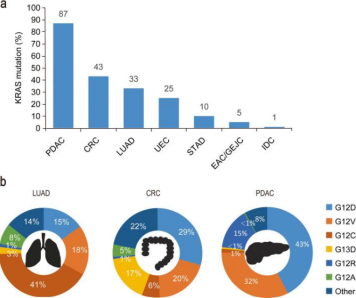
Figure 1: Proportion of KRAS mutation in different types
of cancer, data from AACR GENIE 9.0 database [1]
However, KRAS lacks classical drug binding sites, and
the binding of activated KRAS protein with GTP has picomolar affinity. Small molecule drugs need
stronger binding power than traditional blockers to compete, so discovering a drug that targets
KRAS mutants is a great challenge.
So far, scientists have made a lot of efforts for
KRAS. With the approval of the FDA for listing of Amgen's KRAS G12C inhibitor (AMG-510), the
"curse" that KRAS cannot be targeted has ended, and the prelude to the development of KRAS
inhibitors has been opened. Finding new cancer treatment targets had become a trendy topic. Of
course, it is difficult to design inhibitors directly targeting KRAS, so many scientists focus
on targeting upstream regulators or downstream effectors of KRAS.
The disease models benefit the development of new drugs targeting KRAS
mutations. The point mutation cell models can reveal the cell biological principles related to KRAS mutations, which can promote human disease prevention, new drug
and clinical treatment development. Next, we will discuss the current KRAS
targeted drug development ideas and the applications of point mutation cells in KRAS mutation
research.
Research
ideas of drugs for KRAS-mutated cancers
As mentioned above, it is very difficult to
directly target KRAS with drugs. Therefore, researchers have been trying to find relevant indirect ways
in the past 40 years, and have explored several research ideas with high feasibility, including reducing
the expression of KRAS, interrupting the membrane localization of KRAS, interfering with the interaction
between KRAS and its effectors, inhibiting upstream and downstream signals, synthetic lethality method, etc. Here is a brief introduction to the common
ideas of KRAS-targeted drug development:
1)Selective inhibition of KRAS mutation
To design inhibitors with good specificity
for KRAS mutations, so as to reduce the expression of KRAS mutants and inhibit the canceration caused by
continuously activated KRAS mutants.
2)Inhibition of farnesyltransferase
activity
The biological activation of KRAS protein
needs to be combined with the membrane. By inhibiting the activity of farnesyltransferase, the farnesyl acylation of
KRAS protein can be inhibited, thus reducing and interrupting the localization of KRAS protein on the cell membrane. Therefore, farnesyltransferase is also a target for
developing cancer therapy related to KARS mutation.
3)Design
inhibitors for KRAS-SOS binding region
The normal activation of KRAS requires the
involvement of SOS protein. Therefore, another design idea of drugs is to design targeted inhibitors for
KRAS-SOS binding region.
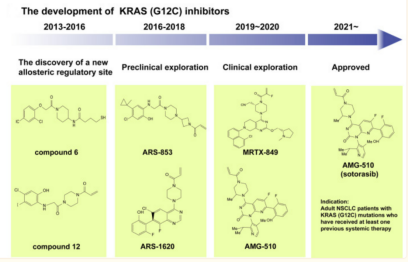
Figure2: Research progress and chemical structures of KRAS (G12C) inhibitors
Based on the breakthrough of the "indirect
approach", in recent years, there have been several good news of KRAS inhibitors discovery-- AMG-510,
the approved treatment for patients of non-small cell lung cancer (NSCLC) with KRAS G12C mutation, who
have received at least one systematic treatment; Mirati Therapeutics has two KRAS inhibitors and their
efficacy has been verified in clinical and cancer models respectively; Revolution Medicines also has a
KRAS inhibitor that shows good anti-cancer activity in cancer models. Therefore, researchers' enthusiasm
for KRAS research has also continued to rise.
Case studies of
KRAS point mutation cells
Cell line model is the most commonly used tool in human
disease research. It can be used in target validation, target discovery, drug screening, etc., which is helpful to comprehensively
understand the nature of disease, and provides an effective means for human to defeat malignant tumors
and carry out more in-depth research. Here are some application cases of KRAS point mutation cells in
target research.
(1)Effect of KRASG12C mutation on translation mechanism mediated by
different signal pathwaysThe EGFR (15-50%) or KRAS (20-30%) oncogenic mutations
detected in lung cancer can activate MAPK and/or PI3K/AKT/mTOR signaling pathways, which target
translation initiation factors of important genes. KRAS mainly causes abnormal signal
transduction even without extracellular stimulation through mutations at G12, G13 and Q61 loci. KRASG12C is one of the most common carcinogenic mutations
in lung adenocarcinoma and a promising therapeutic target of small molecule inhibitors. KRAS
oncogenic signal pathway is responsible for regulating tumor microenvironment, and translation
factor is one of the most significant down-regulation targets. It has been reported that the
analysis of EGFR wild-type CL1-5 and A549 cells integrated with inducible KRASG12C expression system showed that the cap dependent
translation function of mTORC2 and NF-κB in CL1-5 cells was impaired. A549 cells
containing KRASG12C mutation can promote cap dependent translation
by recruiting mTORC1, c-MYC and eIF4F complexes [2]. After prolonging the induction of KRASG12C in a mTORC1/p70s6k independent manner, the
translation rate of CL1-5 cells was restored. The results show that KRASG12C signal affects the regulation of translation
mechanism to some extent. The construction and research results of these point mutation cell
lines can provide more references for the molecular mechanism of KRAS gene mutation and
downstream phenotypic events, and provide new ideas for the development of specific targeted
drugs for KRAS.

Figure
3: Phenotype of A549 and CL1-5 KRASG12C tet
induced point mutation cell lines [3]
(2)Verify
KRASG12C-G12V double mutation and KRASG12F resistance to G12C specific
inhibitor [3]
The invention of KRASG12C covalent inhibitor is an important
milestone in the treatment of RAS mutation cancer, so it is significant for the treatment of
non-small cell cancer (NSCLC). Vaclova et al.
studied whether there are other KRAS mutations co-occurring with G12C mutation in NSCLC, and
whether this co-mutation will affect the sensitivity of cells
to G12C specific inhibitor (AZ'8037). After analyzing the data of SELECT-1 phase 3 study (NCT01933932),
they found that the mutation that often occurs with G12C mutation (c.34G>T) in NSCLC is c.35G>T, and this co-mutation has two cases: cis and trans. The
cis mutation will produce G12F mutant KRAS protein, and the trans mutation will produce G12C and G12V
mutant KRAS protein.
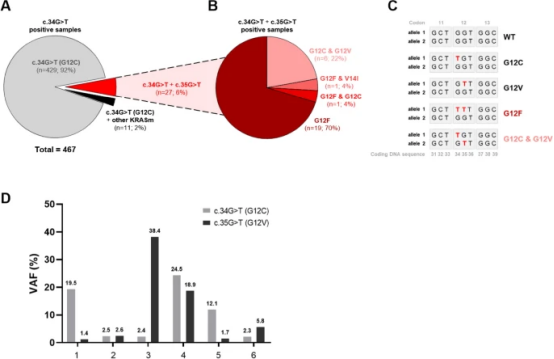
Figure
4. Analysis of the co-occurrence
of KRAS G12C (c.34G>T) and other KRAS mutations in NSCLC patients
Then, to verify whether the co-mutation will affect
the effectiveness of G12C specific inhibitors, Vaclova et al. used CRISPR/Cas9 technology to
introduce c.35G>T mutation, they constructed
KRASG12C-G12V double mutation and KRASG12F point mutation NCI-H358 cells, and studied the
sensitivity of these two cells to G12C specific inhibitors. The results showed that, compared
with KRAS G12C cell line, the sensitivity of the two kinds of cells with co-mutation to the G12C
specific inhibitor AZ'8037 was significantly reduced.This study suggests that the frequency of KRAS double
mutation should be paid attention, and multi region tumor sequencing should be carried out to
avoid missing KRAS subclone mutants. There is still a long way to go in the development of KRAS
inhibitors.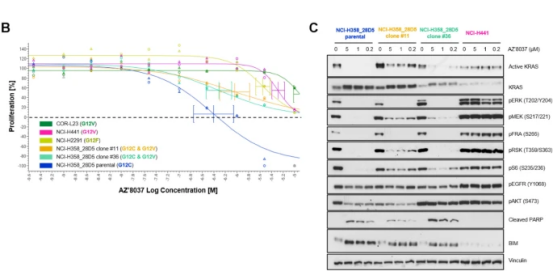
Figure 5. The effect of AZ'8037 on the
activity of KRAS mutant cell model and Western blot analysis
Although decades of studies have emphasized that KRAS
mutation is the core factor of tumorigenesis and clinical drug resistance, no effective
treatment for KRAS mutation has been found, so it is urgent to study KRAS mutation. The popular
kinase genes that are also related to cancer and are easy to mutate include EGFR, BRAF, PIK3CA,
MET, NRAS, etc. At present, many researchers have chosen to build point mutation cell models for
reducing gene mutation disease models to screen and verify new drug targets.CRISPR -
U™ exclusively developed by Ubigene can greatly improve the efficiency of
homologous recombination. It can easily build point mutation cell models with four different point mutation methods (RNP
method, antibiotic resistance method, single base editor, AAV Monor method) and the Red cotton CRISPR point mutation strategy designer. Now, for the above popular kinase gene mutations, only $6480 to generate point mutation (PM) cell lines, deliver as
quickly as 8 weeks. Click here to learn more
details of our point
mutation cell line service>>
Related
products:
3000+ KO cells in
stock>>cover most studied genes of signal pathway mentioned in this article, which is a
powerful tool for the research of therapeutic targets for mutation diseases. Deliver in 1 week,
only $1780!
References:
[1]
Huang L, Guo Z, Wang F, Fu L. KRAS mutation: from undruggable to druggable in cancer. Signal Transduct
Target Ther. 2021;6(1):386.
[2] Kyriakopoulos,
George et al. KRASG12C Can Either Promote or Impair Cap-Dependent Translation in Two Different Lung
Adenocarcinoma Cell Lines.” International journal of molecular sciences vol. 22,4 2222. 23 Feb. 2021,
doi:10.3390/ijms22042222
[3] Vaclova,
T., Chakraborty, A., Sherwood, J. et al. Concomitant KRAS mutations attenuate
sensitivity of non-small cell lung cancer cells to KRAS G12C inhibition. Sci Rep 12, 2699
(2022). https://doi.org/10.1038/s41598-022-06369-3











